Contact
![]()
 Maria Strack, Department of Geography and Environmental Management
Maria Strack, Department of Geography and Environmental Management
 Scott J. Davidson, Department of Geography and Environmental Management
Scott J. Davidson, Department of Geography and Environmental Management
Introduction
Wetlands are a key component of the terrestrial carbon cycle and important for mitigating climate change. Swamps, which are characterized by woody vegetation cover, represent large areas of North America’s wetlands, and are comparatively understudied and largely missing from greenhouse gas (GHG) inventories. A better understanding of swamp carbon stocks and fluxes, and how they vary from other wetland types, is required to support improved wetland mapping and climate and earth system modelling efforts.
This study used a literature review to compare vegetation biomass and net primary productivity (NPP), carbon dioxide (CO2) and methane (CH4) fluxes, dissolved organic carbon (DOC) concentration and export, and soil carbon stocks from four distinct swamp types across Canada and the United States. The study aimed to answer i) how variable are carbon fluxes and stocks among swamp types; ii) how do swamp carbon fluxes and stocks compare to other wetland and upland forested ecosystems; and iii) what are the most significant research needs to better quantify the role of swamps in the global carbon cycle?
Methodology
Four swamp types were defined based on dominant vegetation cover: broad-leaved, needle-leaved, mixedwood and shrub/ thicket (Figure 1). The study only included freshwater swamp on either mineral or organic (e.g., peat) soils.
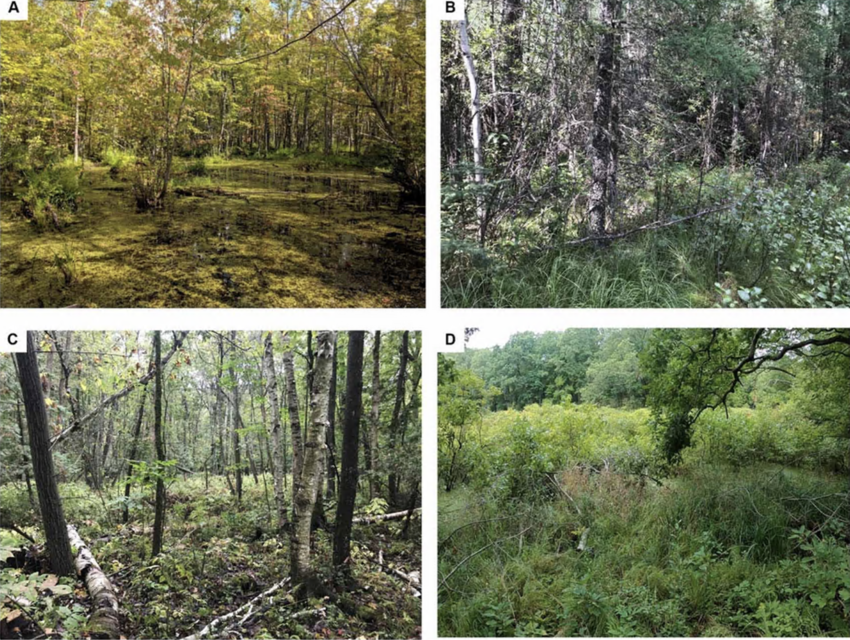
Figure 1: Example photographs of the four main swamp types (A) broad-leaved (photo credit: Dean Hiler) (B) needle-leaved (photo credit: Scott J Davidson) (C) mixedwood (photo credit: Scott J Davidson) (D) shrub/thicket (photo credit: Lars Brudvig).
A comprehensive keyword search was conducted on Web of Science to locate literature that reported vegetation biomass, carbon flux and NPP data for swamps or forested wetlands. A total of 15 papers for CH4 fluxes, six papers for CO2 fluxes, seven papers for DOC and over 20 papers for NPP/biomass across both Canada and the United States were identified. Three databases i) a wetland database for the Western boreal, subarctic and arctic regions of Canada, ii) surveys of peat and peatland resources for southeastern, northwestern and northeastern Ontario and iii) the Neotoma Paleoecology Database were used to compile a dataset of 247 cores to compare swamp soil properties across swamp types.
Statistical analyses were performed using R 3.5.3. Analysis of variance and post-hoc Tukey tests were used to determine statistical significance of differences between swamp peat core sections from swamp types. Linear regressions were used to examine relationships between water table depth and both aboveground net primary productivity (ANPP) and CH4 fluxes.
Outcomes
The study found that average aboveground biomass was greatest in needle-leaved swamps, while aboveground NPP was more similar between swamp classes. A negative relationship between depth of water table and ANPP was found, with ANPP decreasing as water tables become shallower likely due to stress causes by anoxic soil conditions (Figure 2). Given that most of the biomass measurements were from south of 40th parallel North, mean values likely overestimate biomass in cool temperate and boreal swamps. Based on a small number of studies, belowground biomass made up a relatively small proportion of total biomass in swamps with shallow water tables or flooded conditions likely limiting root growth.
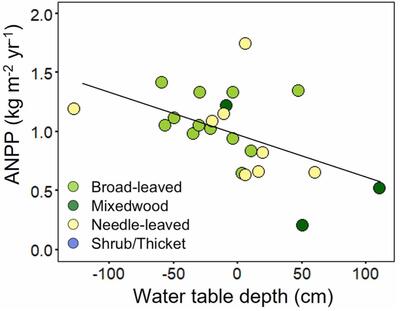
Figure 2: ANPP as a function of water table depth. A positive water table depth value indicates the water level is above the ground surface.
Only seven studies were found that assessed soil CO2 fluxes from swamps, with the largest emissions reported from a mixedwood swamp in southern Ontario. As with other wetland types, high water tables can lead to a reduction in CO2 production and lower emissions, conversely, as water table levels drop, CO2 emissions may increase as oxygen availability within the soil column increases.
From the 15 studies identified that reported soil CH4 fluxes, emissions were substantially higher in broad-leaved swamps compared to other swamp classes. The largest fluxes from all swamp types came from swamps located in temperate to sub-tropical regions with average fluxes becoming smaller towards the boreal zone. Nearly all sites were a CH4 source during the growing season. In addition, a relationship between increasing water table depth and larger CH4 fluxes was found with higher CH4 emissions when the water table was near or above the surface (Figure 3).
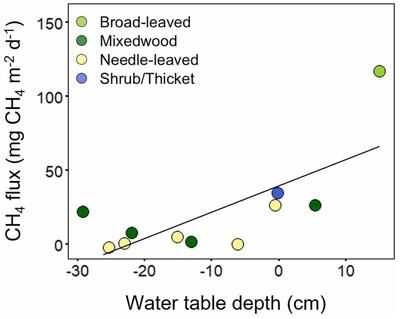
Figure 3: Swamp methane (CH4) flux as a function of water table depth (cm). A positive water table depth value indicates the water level is above the ground surface.
Comparing DOC concentrations among studies was complicated because different sampling methods were applied. Three studies reported net DOC export from swamps, but the review cautioned that, as hydrology varies between swamps, both DOC inputs and outputs must be taken into account to determine the DOC load attributable to the swamp alone.
Comparison of soil properties indicated that broad-leaved swamps have significantly higher bulk densities and lower organic matter contents than the other three swamp types perhaps reflecting their hydrologic setting and readily decomposable leaf litter. Peat depths and organic matter contents were lower in broad-leaved swamps, likely because of seasonal declines in the water table and oxic conditions. While mineral swamps may contain significant soil carbon stocks, peat swamps in particular can have substantial organic matter accumulation due to persistent waterlogged conditions and slower decomposition rates (Figure 4).
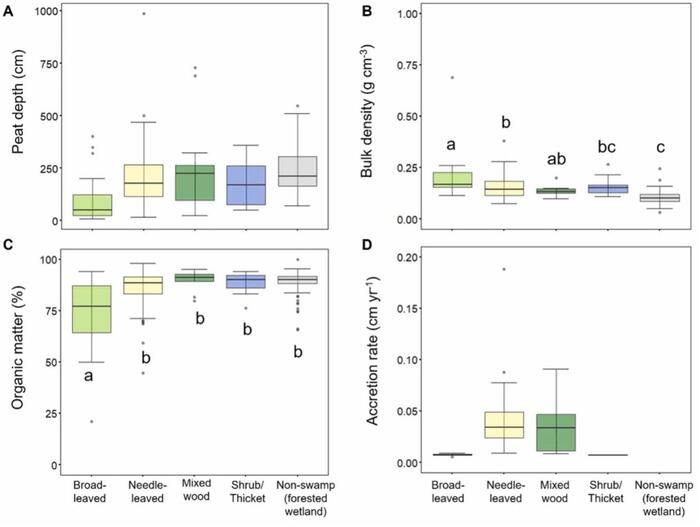
Figure 4: (A) peat depth (cm), (B) bulk density (g cm3), (C) organic matter (%) and (D) rate of peat accretion (cm yr−1) for swamp types and forested wetlands. Each point represents the mean value of one peat profile. Lower case letters indicate significant difference between swamp types (ANOVA, p < .0001).
In summary, the study clearly indicates that swamp ecosystems are important components of the terrestrial carbon cycle in Canada and the United States (Figure 5).
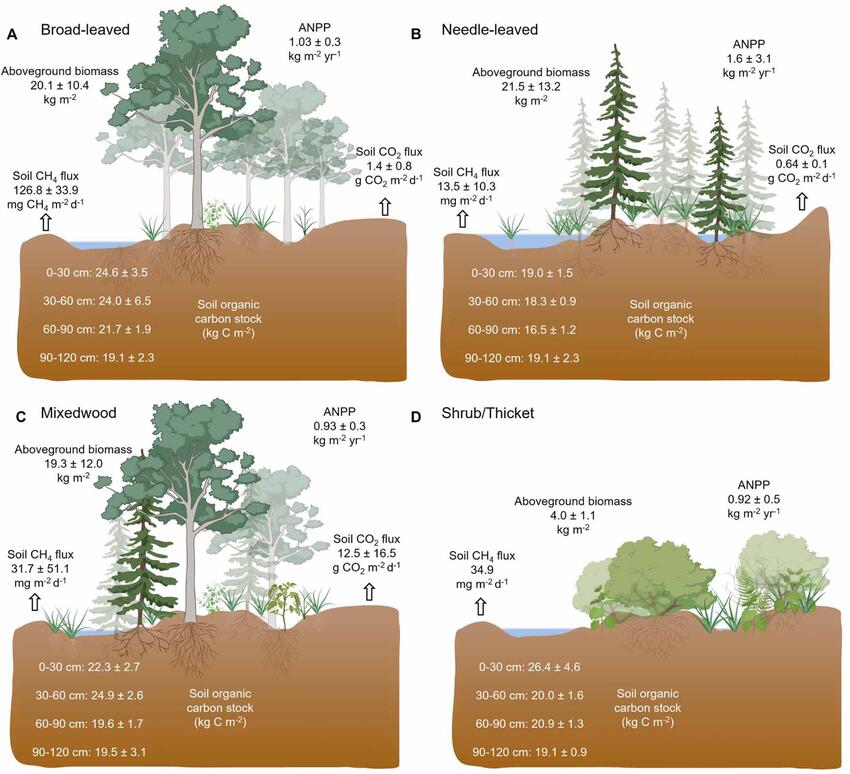
Figure 5: Summary of mean (±SD) ANPP, aboveground biomass, growing season soil CO2 flux and CH4 flux and total soil organic carbon stock for depths 0–30 cm, 30–60 cm, 60–90 cm and 90–120 cm where available for (A) broad-leaved, (B) needle-leaved, (C) mixedwood and (D) shrub/thicket swamps from the published literature.
Conclusions
The study shows the importance of swamps for wetland carbon storage and important carbon cycling differences among swamp types. It demonstrates that regardless of organic versus mineral swamp definitions, all swamp types are important in terms of carbon accumulation and fluxes.
Broad-leaved swamps are distinct from the other types owing to higher soil bulk densities, thinner peat depths and higher CH4 emissions, likely reflecting seasonal hydrological regimes and ecological conditions. Needle-leaved swamps are particularly important in terms of above-ground biomass and their ability to slowly accumulate significant peat depths over long periods of time, resulting in large soil carbon stocks that cannot be replaced on short- or medium-term timescales following disturbance.
Additional data are needed to improve comparisons among swamp vegetation classes across both climate and hydrological regions as the representativeness of existing studies for capturing the range of hydrological and chemical conditions across swamps remains unclear. More field sampling is needed to determine the drivers of variability in soil carbon stocks to inform upscaling efforts and land use planning. There is also an urgent need to update maps of swamps using consistent definitions across regions. Future research focused on the mapping of swamps should combine the use of optical imagery to identify the dominant vegetation with methods that map topography or wetness.
Davidson, S.J., Dazé, E., Byun, E., Hiler, D., Kangur, M., Talbot, J., Finkelstein, S. A., and Strack, M. (2022). The unrecognized importance of carbon stocks and fluxes from swamps in Canada and the USA. Environmental Research Letters, 17, 053003. https://doi.org/10.1088/1748-9326/ac63d5
For more information about WaterResearch, contact Julie Grant.






